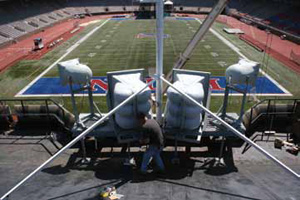Survival Materials

Part Two In The Outdoor Sound Saga Tests Loudspeakers ’ Construction Mettle
QUICK BIO
NAME: John Loufik
COMPANY: Community Professional
WEATHERPROOFING: Loufik has an IP67 Rating, Mil Spec Rating Classified.
Careful attention must be given to all of the materials used in the loudspeaker’s construction and mounting to ensure an enduring outdoor system. Not all materials can simply be “weatherized” by applying an extra coat of paint, sealant, or other additive. In many cases, alternative, more rugged materials must be sourced in order to truly protect the loudspeaker at the component level.
Beginning with the most important component in any loudspeaker, consider the materials used to fabricate the drivers (woofers, mid-range drivers, compression drivers, etc.). Better material choices include non-metallic (such as mylar), corrosion resistant metals such as titanium, and highly inert materials such as carbon fiber, or paper cone drivers treated with water sealants to shed moisture.
Next, evaluate the cabling, connections, and other components in the wire path. Designs with watertight connectors are very rare and demand a premium for those connectors. Alternatively, consider connector-less features that seal an ingress cable into the cabinet so that the loudspeaker termination must be made external to the cabinet in a standard weather-tight electrical box (which will likely be required in the conduit path anyway).

Yeadon, PA-based Clear Sound recently upgraded the aging sound system at the University of Pennsylvania’s Franklin Field with Community Professional R-Series weather-resistant loudspeakers powered by QSC amps. A truck-mounted 50-foot crane was brought in to mount two Community R2-77Z long-throw full-range and two R6-51 multidriver vertical array systems.
A daily selection of the top stories for AV integrators, resellers and consultants. Sign up below.
Most often, loudspeaker cabinets are constructed from wood products—particularly plywood. Can this be suitable outdoors? Yes if the wood itself has been treated for “marine use” and all of the cabinet internal and external surfaces (and joints) are fully encapsulated in an inert coating. Fiberglass external coatings and fiberglass resins have been proven over decades of use for this “encapsulation” process. Better yet, for ultimate weather resistance, what if the entire cabinet was constructed from fully seam-sealed inert materials such as polyethylene, fiberglass, plastic, etc.?
Successful outdoor loudspeaker systems add an important dimension to entertainment and communication for a wide variety of audiences. Observing the common challenges described above will help prevent costly errors, but there are many other important aspects to consider. Be sure to research all of the conditions that may affect the systems you implement. Seek assistance with any factors that present challenges new to you that might compromise the system’s design and safety. When in doubt, plan for the worst and hope for the best!
John Loufik (jloufik@communitypro.com) is senior applications engineer for Community Professional Loudspeakers.
